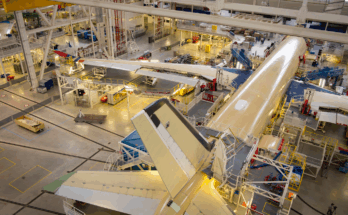by Richard Pettibone, Aerospace & Defense Companies Analyst, Forecast International.
As the primary foundation upon which Russia’s United Aircraft Corp has been built, Sukhoi remains the strongest of the Russian manufacturers. The company’s success is due to two programs: one civil aircraft, the Sukhoi Superjet 100; and one military, the Su-35 fighter.
The company’s new Sukhoi Superjet 100, a program that could be worth about $12 billion over the next 20 years, continues to move forward – no mean feat considering the world’s recent economic woes. The company is also working on a $2.65 billion contract for additional Sukhoi fighters for the Russian Air Force. The initial success of these efforts has kept capital flowing into the firm and earned it a pre-eminent place in the long-drawn-out restructuring of Russia’s aerospace industry.
But now, Sukhoi’s Superjet program is facing some interesting times. The aircraft has entered production just as relations with the West have cooled over the conflict in the Ukraine. The SSJ 100 contains a large number of components sourced from outside Russia. Existing and potential sanctions in America and parts of Western Europe – due to the ongoing diplomatic fallout – endanger supplier relationships.
One of Sukhoi’s Western partner’s in the program is already cutting its losses. Italy’s Leonardo has seen its holding in the Sukhoi Civil Aircraft Company reduced due to capital infusions from Moscow. According to reports, Leonardo would have to infuse some $390 million to regain its former stake. However, as the company is in the midst of a restructuring aimed at shedding loss-making operations such as SCAC, it balked at this.
As a result, the current status of the Leonardo holding (which stood at slightly over 5 percent in early 2016) is unclear. Meanwhile, Moscow has moved ahead to wholly consolidate the operation under Sukhoi, approving a request to purchase Leonardo’s stake. In addition, SCAC is pushing a recapitalization effort aimed at raising some $3.7 billion by issuing new shares. It remains to be seen how successful this effort will be considering the rough shape of the Russian economy.
Despite the drama, the program will move along, driven primarily to fulfill the needs of the Russian market. While Sukhoi believes the Superjet can eventually reach a production rate of 50-60 aircraft per year, the forecast will likely hover at a fraction of that – perhaps 20 at most – according to Forecast International’s Civil Aircraft Forecast.
In terms of military aircraft, Sukhoi scored a major win in late 2015 when China finally signed on to a long-awaited $2 billion deal for 24 Su-35 fighters. The deal – which marks the first export of the aircraft – was delayed over Russian concerns that China would just reverse-engine the aircraft, as it had many times in the past. The deal included caveats that no local production of the aircraft would occur in the Middle Kingdom.
At home, Sukhoi is developing Russia’s fifth-generation fighter, the T-50 PAK FA. However, this effort has not been as successful as the Superjet. The program has been beset with technical, industrial, and political delays that have pushed its entry into service to 2017 at the earliest, and even this is considered optimistic. The partnership with India over financing and development further complicates matters.
Adding to the program’s woes, Russia announced in late 2015 that it would initially only induct a squadron (18-24 aircraft) of PAK FA fighter aircraft, and procure additional Sukhoi Su-35 aircraft instead. Originally, Russia was looking to acquire 250 aircraft by 2022, and India some 140. Disagreements that arose between the two partners led Russia to offer to reduce India’s financial commitment from $6 billion to $3.7 billion to remain in the program, along with substantial technology transfers.
The Russian government needs India’s help to fund development of the T-50, an aircraft being built to match the reputed capabilities of the U.S. Air Force’s stealthy F-22. In exchange for funding, India will receive a 50 percent share in engineering and intellectual property rights for any exports of the completed aircraft. There was concern that India’s selection of Dassault’s Rafale could lead to a cash crunch, which would then be resolved by dropping the PAK FA program. However, with a reduced number of Rafales being acquired, the PAK FA program may still be viable in India if its affordability is kept in check.
The issues with the T-50 program have opened up opportunities for Sukhoi to supply an interim aircraft – the Su-35 – to meet Russian Air Force needs. In August 2009, Sukhoi was awarded just such a deal in the form of a $2.65 billion contract for 48 Su-35S fighters, along with 12 Su-27Ms and four Su-30M2s. This gap-filling measure gives Russia’s industrial base time to develop the skills and technology (especially in composites) needed for the PAK FA. Further, the Su-35 order keeps skilled labor working until the new aircraft is ready to enter production.
The Defense & Aerospace Companies series focuses on worldwide aerospace and defense prime contractors and subcontractors. Concise reports provide data on individual corporations regarding recent mergers, restructurings, and joint ventures, along with a Strategic Outlook that examines the company’s strengths, weaknesses, and opportunities. Also included in each report are financial and industrial segment data, snapshot coverage of major programs, and recent U.S. Department of Defense contract awards.
A military history enthusiast, Richard began at Forecast International as editor of the World Weapons Weekly newsletter. As the Internet grew in importance as a research tool, he helped design the company's Forecast Intelligence Center and currently coordinates the EMarket Alert newsletters for clients. Richard also manages social media efforts, including two new blogs: Defense & Security Monitor, covering defense systems and international issues, and Flight Plan, which focuses on commercial aviation and space systems. For over 30 years, Richard has authored the Defense & Aerospace Companies, Volume I (North America) and Volume II (International) services. The two books provide detailed data on major aerospace and defense contractors. He also edits the International Contractors service, a database that tracks all the contractors involved in the programs covered in the FI library. More recently he was appointed Manager, Information Services Group (ISG), a new unit that encompasses developing outbound content for both Forecast International and Military Periscope.




